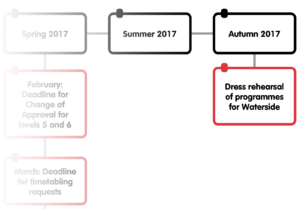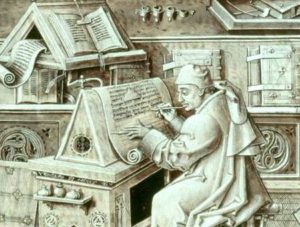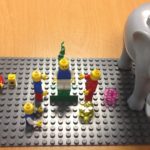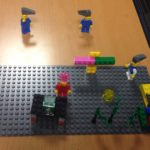“First year BA Advertising are given a live brief to deliver. Last year it was wrapping a taxi – see article here http://www.northampton.ac.uk/news/advertising-students-
take-part-in-a-taxi-wrap-challenge-to-promote-the-university-of-northampton.
This year they are working on developing a Mascot for the University and using it in a number of promotional situations, such as a Saints game or an awards ceremony. Next year, it will be something different. The main point is that it is real and they have to deliver everything from pitching for funding, through to execution.
I refer to the assessment as ‘Reportage’. A group report documents the steps in the process, with an emphasis on the role their team played. Also, this piece of work includes an individual reflection. I’m not sure that it is earth-shattering in terms of process, but it is authentic, very organic (full of challenge and uncertainty) and the student feedback has been very good”.
For more information about this assessment, please contact Kardi Somerfield, Senior Lecturer in Marketing (Kardi.Somerfield@northampton.ac.uk)
This case study is taken from the Institute of Learning and Teaching’s 2015 publication ‘Outside the Box Assessment and Feedback Practices’, available from the University’s Assessment and Feedback portal.
The BA in Policing programme uses an extended role play involving a robbery incident. This assessment requires students to deal with an incident from first report through to appearing in court to give evidence. The exercise requires them to devise their own investigative strategy and if they make the right enquiries, they are fed extra snippets of information that should lead to an arrest of the suspect. Students interview the suspect using the tape-recorded interview method and then submit the file to the Crown Prosecution Service for a decision as to whether or not to charge the suspect.
For more information about this assessment, please contact Bob Lyman, Senior Lecturer in Criminal Justice Practice (Bob.Lyman@northampton.ac.uk)
This case study is taken from the Institute of Learning and Teaching’s 2015 publication ‘Outside the Box Assessment and Feedback Practices’, available from the University’s Assessment and Feedback portal.
 NILE sites will be sampled by the Quality and Partnerships team from 1st August 2015 in readiness for QAA so it is important that sites comply with the baseline standards which were approved at University Student Experience Committee on 16th June, 2015. In addition, there are a number of common problems that could have a negative impact on student experience and generate avoidable requests for assistance from you and other teams supporting students.
NILE sites will be sampled by the Quality and Partnerships team from 1st August 2015 in readiness for QAA so it is important that sites comply with the baseline standards which were approved at University Student Experience Committee on 16th June, 2015. In addition, there are a number of common problems that could have a negative impact on student experience and generate avoidable requests for assistance from you and other teams supporting students.
LearnTech have been asked to provide some simple guidance on preparing your 2015/16 NILE sites to ensure they meet foundation level at the very least.
We have managed to condense the main points down to one page, which you can download here. Following these simple guidelines should help to save time once teaching begins.
The preparation of sites for the 2015/16 academic year is now starting in earnest and you may find yourself copying material from last year’s sites. Usually this is fairly easy using the ‘copy’ dropdowns, but one section that is a little more difficult is ‘Contacts’. It isn’t possible to copy individual contacts from one site to another, but you can copy the whole Contacts folder even if this isn’t immediately obvious. Especially as you probably only ever do this once a year!
One advantage of this full copy process is that you can create a ‘Master’ contact list to import into all your modules with every contact, then just delete those you don’t need on a particular module.
We have created a quick one-page guide to jog your memory and help you speed things up. The same principle can be applied to large content areas with lots of content. Rather than copying items individually you can move across all the content of a menu item on the left side. Just select that item instead of ‘Contacts’ for the Export and Import content.
At the start of July MyPad will be updated. If you’re a user, staff or student, with a blog (or blogs), please read how this may effect you and what action is needed.
To begin, it’s important to stress no content will be lost during these changes. It may, however, look a little different; here’s why…
Out with the old
A theme controls the look of your website (the colours on the page, the position of elements, the fonts used, etc). Around 50 of the oldest themes in MyPad are set to be retired.
This is happening because these themes are out-of-date and not suitable for all computers. For instance, use on mobile devices is now an important consideration, which these older themes don’t support.
This will affect many users, but not everyone. To see if your theme is amongst those marked for deletion, please check the full list below.
73 Class
Almost Spring
Ambiru
anarchy
Andreas10
Anubis
Arclite
Batavia
Benevolence
Black-LetterHead
Blak Magik
Blix
BlogTheme
Blue Green
Blue Moon
Blue Zinfandel Enhanced
Bluebird
Borderline Chaos
BuddyPress default
Cellar Heat Dark
ChaoticSoul
Citrus IslandWP
CleanTidy
Color Paper
Color Splash
Connections
Contempt
Copyblogger
Cordobo Green Park
Crop Circles
Cutline
Daisy Rae Gemini
Day Dream
Deep Blue
Deichnetz
Diary-cute
Digg 3 Columns
Dignity
Dixie Belle
Doc
Edublogs Classic
Edublogs Premium Homepage
Edu Campus
Emptiness
Fadtastic
Falling Dreams
Fauna
Fjords
Flex
FrameTheme
Fresh Bananas
Freshy
Fusion
Garland
GenkiTheme
Gentle Calm
GloriousDay
GlossyBlue
Golf
Gonzo Daily
Grassland
Green Marinée
Greenday
Greenery
Gridlock
Hemingway
Hero
iBlog
Jakarta
Japan Style
Journalist
jQ
K2
Kubrick
LetoPrime
LetterHead
Light
Liquorice
Magazeen
man~ja
Mandigo
Minimalist
MistyLook
Monotone
Mystique
Newsportal
Nikynik Blue
Northern-Web-Coders
Ocadia
Ocean Mist
OceanWide
P2
Pink-Kupy
Pixel
Pool
PressRow
PrimePress
Primitivo
Quadruple Blue
Quentin
RadMod
Reaching Darkness
Redoable
Regulus
Retweet
RoundFlow
Rubric
Runo Lite
SeaShore
Simpla
Simplr
Skinbu
Solipsus
Steam
Strange Little Town
StripedPlus
Suhweet
sumenep
Sweet Blossoms
Tarski
Technical Speech
TerraFirma
Thematic
Thoughts
Trevilian Way
Tropicala
Twenty-eight Thirteen
Twilight
Vertigo
veryplaintxt
Vistered Little
Waterlily
White as Milk
WordPress Classic
WordPress Classic
WordPress II Silver
WP-Andreas
WPMU Dixi
WPMU Nelo
WPMU Triden
Know your theme

MyPad dashboard
To know which theme you’re using:
- Login to MyPad
- Go to your dashboard
- Look in the ‘this blog’ box (top left)
- The theme in use is listed
How to change

Theme settings
If your theme is one marked for deletion, you’ll need to change it.
To do so, in the left-hand menu choose:
- Appearance > themes
All the themes listed are usable, so pick one you like the look of (those marked for retirement are hidden from view).
If you’d like to see all the new themes in more details, have a browse of the gallery.
To activate, hover over the thumbnail and click activate.
What if?
The deadline to make this change is 7th July. If you haven’t changed by then your current theme will be deactivated and will be changed to the new default – Twenty Fifteen.
No content will be lost, but your blog or website will look different as a result. You’ll simply need to login again and rearrange the display.
If you have any questions or concerns, please email LearnTech for advice.
 At the recent Learning and Teaching Conference, the Learning Design team hosted a ‘cracker barrel’ table to help staff think about how to approach course (re)design. Those that came to the session were also given an action planner document, which included key dates in the academic calendar between now and the autumn term 2017, when most programmes will be expected to be running in a format appropriate to Waterside delivery.
At the recent Learning and Teaching Conference, the Learning Design team hosted a ‘cracker barrel’ table to help staff think about how to approach course (re)design. Those that came to the session were also given an action planner document, which included key dates in the academic calendar between now and the autumn term 2017, when most programmes will be expected to be running in a format appropriate to Waterside delivery.
For anyone that missed the session, you can find the planner here: Planning for Waterside timeline (PDF, 275KB)
If you would like any help with your planning, please contact the Learning Designers at LD@northampton.ac.uk.
 The June 2015 roundup of LearnTech news is now available
The June 2015 roundup of LearnTech news is now available
When it comes to publishing online – on NILE, MyPad or other websites – copyright legislation is an important consideration that can too often be overlooked.
Arbitrarily using text, images, audio or video from other websites in your work runs risk. It’s not great to use NILE’s password protection, or ‘it’s for educational use’ as legitimate excuses.
So to help you produce trouble-free online content we’ve put together a quick guide to what you can and cannot do, and good places to find great resources.
Copyright Basics
To help ease you into this complex world, the Copyright Hub has an interactive guide with a vast wealth of resources.
It’s worth remembering Copyright sits alongside Trademarks and Patents and Designs and is overseen by the Intellectual Property Office (IPO).
This is not to be confused with Data Protection and Freedom of Information which fall under the remit of the Information Commissioner’s Office (ICO)
Copyright exists to protect work and permit its owner to dictate how, where and when this is used. It doesn’t always prevent republishing, but will dictate the terms of use.
Creative Commons
A common way to find and use material online, legally and for free, is by using Creative Commons content. Where applied, a copyright owner will permit the use of their work in the following ways:
- attribution only, with no further restrictions,
- no commercial uses of the work,
- no derivatives (adaptations) can made of it.
You may have already considered using this when posting your own copyright material on the web.
Websites
Information which is freely available on the internet isn’t necessarily free to copy. Websites are protected by copyright and some sites may also be considered as databases and be protected by database right.
The material published on a website is protected by copyright in the same way as print material. Most will have a copyright declaration or specify how material from the site may be used. Although if missing, it’s best to assume the usual restrictions apply and only use a small amount for private, non-commercial purposes.
If the information on the website is not easy to access – it’s password protected for instance – then this implies the owner is protecting their work and does not want it to be copied or distributed freely; even if there is no charge for using the site.
Not all the information on the internet has been posted legally, so be careful to check the source of the information where it is possible, and use your own judgement where it is not.
Images
When looking for images it’s tempting to use anything that’s readily available! Jisc’s interactive guide gives you a safer approach.
It’s better to use a search engine that displays only Creative Commons licensed images, or those that have been made available rights free.
- Creative Commons search
- Flickr (advanced search)
- Everystockphoto
- MorgueFile
- Open Clipart
- Xpert
- Canva
If you use Google Images, narrow the usage rights with an advance search. For further advice read Jisc Digital Media – Copyright of still images.
TV, Radio & Sounds
There’s a wealth of videos on sites such as YouTube which you may wish to use in your teaching. Although be mindful it’s not legal to download a video to upload it to your NILE site, or redistribute it in any way. However, it is legal and straightforward to add a link or embed the video in NILE.
The Educational Recording Agency (ERA) licence permits staff to copy, access and use broadcast output for non-commercial educational purposes. This means all scheduled free-to-air radio and television broadcasts may be recorded for the purposes of making ERA Recordings.
To save you the trouble of having to record programmes yourself, as well as providing guidance, the British Universities Film and Video Council also runs the Box Of Broadcasts (BOB) service, to which the University subscribes.
This makes available programmes from over 60 UK channels dating back to 2007 and can to be used in your teaching. What’s more, clips can easily be embedded into NILE.
For further advice read Jisc Digital Media – AudioVisual copyright
Books, Journals and Newspapers
All the electronic resources provided through NELSON are covered by licences. Most e-journal and e-book suppliers prefer their material to be deep-linked within NILE. Guidance on this is available in the downloads section of the Library webpage on the staff portal.
The same licences allow users to make single copies for educational purposes, so you could refer students to a reference or deep-link in these cases. Be suspicious if you find online copies of books or journals you would normally expect to pay for. They could easily be illegal copies.
The University’s CLA licence also allows digital scanned copies of both book chapters and journal articles to be placed into NILE legally (whether we own them already or not). Contact the Digitisation Team for help.
Open Educational Resources
Many institutions from around the world have made available Open Educational Resources (OERs). These are teaching materials including lesson plans, documents and media available for reuse.
It can be time consuming to adapt and localise materials created in other countries, so we recommend you use UK repositories in the first instance, where possible.
To sample websites that offer complete free open courses, have a browse around MIT OpenCourseWare and Saylor courses as examples.
Open Textbooks are available from BCCampus in Canada and a good selection of links are listed on Open Access Textbooks. These are free, open, reusable textbooks in HE and FE.
OMICS provides a list of open access journals in different languages and subjects. The OER Knowledge Cloud also offers many research reports and articles about OER.
And finally – did you know?
- Copyright does not need to be registered and subsists automatically from the moment an original work is created.
- Owning a piece of work, and owning the copyright of that work, are not the same thing.
- Commissioning work by a third-party doesn’t grant you copyright ownership – unless it’s stated in the contractual terms.
There were significant changes to copyright in 2014. Here are some links to explain further.
At recent events, including last week’s Learning and Teaching conference, the Learning Design team have been trying out some new activities to help teaching staff think about how they design for learning. You may have seen some of these new tools and activities described in earlier posts in this category, or had the chance to have a go at using them in development events. In this post I’d like to look at the bigger picture of how these might fit together with some of the other services we offer.
At the conference, we hosted a ‘cracker barrel’ table. The staff that came to see us were offered giant post-its (no small motivation!) in exchange for drawing us a picture of what they value most in their teaching. You can view these in our online album here (we’ll be adding more from other events to this album too):
 |
| What I value most in teaching |
The resulting images were not just works of art. They could also be seen as ‘teaching metaphors’ (McShane 2005). We asked participants to expand on these, and break down what was happening in the image using three key questions:
- what is the role of the tutor?
- what is the role of the student?
- what is the role of technology?
Common themes in the role of the tutor included motivation, guidance, facilitation and enabling, linking learners together and lighting ‘sparks’ and ‘light bulbs’ of understanding. There was also an emphasis on pastoral roles, being ‘approachable’, ’empathetic’ and a ‘confidant’. The role of the student was widely agreed to be participative, with comments noting the importance of engaging, contributing and becoming autonomous. Some comments also noted that the distinction between tutor and student is not so dichotomous, and that learning happens in a community where the participants all learn together. Comments on the role of technology mostly focused on supporting access to learning, as well as ‘fostering community’ and enabling sharing. You can see all the contributions in this PDF file (3.5MB, captured using the Post-It Plus app).
 Sadly that was all we had time for on the day, but we did ask them to go away and think about how their image related to their own programmes and modules. Is that ideal teaching moment what’s happening in those modules now? And if not, what could they change that might enable them to do more of what they value?
Sadly that was all we had time for on the day, but we did ask them to go away and think about how their image related to their own programmes and modules. Is that ideal teaching moment what’s happening in those modules now? And if not, what could they change that might enable them to do more of what they value?
This led me to think about a model that I had been introduced to by our very own Deborah Forbes, in a staff development session on Thriving in a Changing Environment*. The model is Appreciative Inquiry (AI), and as a positive approach to change management it has a lot to offer as we prepare for Waterside. Here’s what some of the experts have to say about AI:
“The traditional approach to change is to look for the problem, do a diagnosis, and find a solution. The primary focus is on what is wrong or broken …Appreciative Inquiry suggests that we look for what works in an organization …Because the statements are grounded in real experience and history, people know how to repeat their success.” (Hammond, 1998, pp.6-7)
And:
“[Appreciative Inquiry] deliberately seeks to discover people’s exceptionality – their unique gifts, strengths, and qualities. It actively searches and recognizes people for their specialties – their essential contributions and achievements. And it is based on principles of equality of voice – everyone is asked to speak about their vision of the true, the good, and the possible.” (Cooperrider, 2001, p.12)
Although there is no one definitive model for AI, the 4-D aproach is widely used. This consists of four main steps:
- Discover: The identification of organisational processes that work well.
- Dream: The envisioning of processes that would work well in the future.
- Design: Planning and prioritising processes that would work well.
- Destiny: The implementation (execution) of the proposed design. (Cooperrider and Whitney, 2005, p.17)
In terms of programme and module design, the steps we covered at the conference were targeted at the ‘discover’ and ‘dream’ stages – by helping staff to think about what works really well for them and their students, they can begin to think about what their programme or module might look like if they did more of it. This begins a process that then feeds in to the beginning of the CAIeRO, where staff are asked to outline their aims for the programme or module, create a mission statement for it, and think about the ‘look and feel’ (see this post for more on this). The CAIeRO process then leads the course team through the ‘design’ stage towards the ‘destiny’ or delivery of the new or re-designed modules.
Do you have positive stories to share about what you love about teaching, what’s working well, and what it should look like in the future? Would you like to contribute to the conversation? Then why not add your comments, send us a picture (along with a brief outline of what’s happening), or write us a case study? You can comment on this post, or email the Learning Design team at LD@northampton.ac.uk.
References:
Cooperrider, D.L. (2001) Why Appreciative Inquiry? In Cooperrider, D.L., Hammond, S. and Royal, C. (eds) Lessons from the Field: Applying Appreciative Inquiry. Plano: The Thin Book Publishing Company.
Cooperrider, D.L. and Whitney, D (2005) Appreciative Inquiry: A positive revolution in change. San Francisco: Berrett-Koehler.
Hammond, S. (1998) The Thin Book of Appreciative Inquiry. Plano: The Thin Book Publishing Company.
McShane, K. (2005) Metaphors for University Teaching. Learning and Teaching in Action. 4(1). Available from: http://www.celt.mmu.ac.uk/ltia/issue10/mcshane.shtml [Accessed 29th May 2015]
* Look out for future sessions on the Staff Development site on NILE (note, you will need to be logged in to NILE for this link to work).
Or, how can Lego help you to build a course or module?
Introduction to Programme Design is a one hour staff development session for new academic staff. The session covers key information that staff need to know about how programme and module design works at the University, including signposts to the frameworks and regulations and an overview of the support available.
To help staff start thinking about the complexity of course design, we gave them some lego and asked them to work in pairs to think about the elements that need to be considered, and how they relate to each other.
Why lego?
Why not? Lego is a simple to use, non-threatening tool that helps to externalise people’s ideas in a visual way. It provides a framework for storytelling, and as you will see from the results below, can help teams to synthesise and communicate big ideas. It’s used in many companies as part of a design thinking approach, to help find creative solutions to complex problems*.
Here are some of the elements that Lego helped us to discuss. Each team was given a standard set, along with a single ‘random’ piece. Click on the thumbnail images to view the full scenes:
This team used the lego to show the lecturer and students working within and co-creating a framework, which included other elements like NILE and QAP. The bridge between the students indicates social learning. The scene also includes ‘steps to success’ and a diving board to launch them into their career. The little eyes indicate institutional oversight, and the web is used to catch the students who are not engaged and enable them to ‘bounce’ back in to the course.
This scene has a student at the centre, as the course design starts from their expectations and needs. Alongside the student is an academic and a member of support staff, indicating working in partnership. The shark is about risk: in the form of competition from other universities, and of distractions from learning – the wall is a protection against this. The raised platform indicates student support, including academic standards, facilities like NILE and IT, and skills for employability.
Stakeholders in this scene include service users and commissioners, who are central to programme design for Health courses, as these must consider the needs of the local area in terms of health provision. Other elements include the resources available (lecturers, skills), and the constraints e.g. professional body regulations and quality frameworks. The elephant is Waterside, which will have a ‘massive’ influence on how we move forward with programme design.
The students in this depiction were widely scattered around the room, indicating the ‘geographically dispersed nature of learning communities’. They are connected by mobile devices. The staff member has a movable ‘office’ (which could be at home, a hotdesk, overseas etc). There are signposts for learners throughout the course. The purpose of the course is to help students achieve educational, career and social mobility, indicated by climbing the ladder.
In this scene, the students (on the left) arrive at different levels and some progress faster than others. The programme lead is looking towards them to help them progress. Ahead is the University management and governance, leading the direction of the University. The horse is University strategy, leaping obstacles and providing support to students. On the right is a platform – both for celebration of success (award ceremony) and as a launchpad to a career.
The exercise helped participants to start thinking about the stakeholders that need to be considered in programme design, the aims of their programme or module, and the ways that students are supported. The discussions showed the complexity of the course design process, and shaped our conversations about how it should be supported.
If you were in this session and would like to expand on your model, or if you weren’t but you’d like to respond to the models (or create your own!), please leave us a comment below.
To sign up for a session, visit the Staff Development organisation on NILE (note: you will need to be logged in to NILE for this link to work).
*Although we didn’t have time to use it in this session, the Lego Serious Play website outlines a full methodology for this approach.
Recent Posts
- Blackboard Upgrade – December 2025
- Preparing for your Physiotherapy Apprenticeship Programme (PREP-PAP) by Fiona Barrett and Anna Smith
- Blackboard Upgrade – November 2025
- Fix Your Content Day 2025
- Blackboard Upgrade – October 2025
- Blackboard Upgrade – September 2025
- The potential student benefits of staying engaged with learning and teaching material
- LearnTech Symposium 2025
- Blackboard Upgrade – August 2025
- H5P (HTML5 package) content types meets the needs of Jim Atkinson, Staff Development Trainer
Tags
ABL Practitioner Stories Academic Skills Accessibility Active Blended Learning (ABL) ADE AI Artificial Intelligence Assessment Design Assessment Tools Blackboard Blackboard Learn Blackboard Upgrade Blended Learning Blogs CAIeRO Collaborate Collaboration Distance Learning Feedback FHES Flipped Learning iNorthampton iPad Kaltura Learner Experience MALT Mobile Newsletter NILE NILE Ultra Outside the box Panopto Presentations Quality Reflection SHED Submitting and Grading Electronically (SaGE) Turnitin Ultra Ultra Upgrade Update Updates Video Waterside XerteArchives
Site Admin









